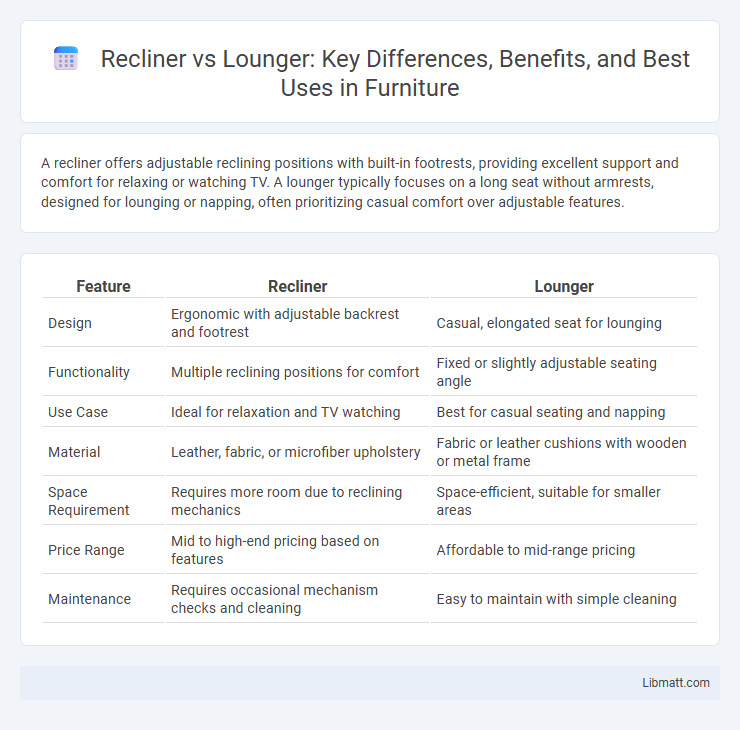A recliner offers adjustable reclining positions with built-in footrests, providing excellent support and comfort for relaxing or watching TV. A lounger typically focuses on a long seat without armrests, designed for lounging or napping, often prioritizing casual comfort over adjustable features.
Table of Comparison
| Feature | Recliner | Lounger |
|---|---|---|
| Design | Ergonomic with adjustable backrest and footrest | Casual, elongated seat for lounging |
| Functionality | Multiple reclining positions for comfort | Fixed or slightly adjustable seating angle |
| Use Case | Ideal for relaxation and TV watching | Best for casual seating and napping |
| Material | Leather, fabric, or microfiber upholstery | Fabric or leather cushions with wooden or metal frame |
| Space Requirement | Requires more room due to reclining mechanics | Space-efficient, suitable for smaller areas |
| Price Range | Mid to high-end pricing based on features | Affordable to mid-range pricing |
| Maintenance | Requires occasional mechanism checks and cleaning | Easy to maintain with simple cleaning |
Introduction to Recliners and Loungers
Recliners and loungers are popular furniture choices designed to provide comfort and relaxation, each with unique features tailored to different needs. Recliners typically offer adjustable backrests and footrests to support various seating positions, enhancing ergonomic support for your body. Loungers prioritize a more casual and open seating style, often without mechanical adjustments, making them ideal for leisurely lounging or reading.
Key Differences Between Recliners and Loungers
Recliners feature adjustable backs and footrests that provide full reclining positions for enhanced comfort and support, while loungers typically offer a fixed or semi-reclined seating posture designed for relaxation without extensive adjustment. Recliners often include built-in mechanisms or motorized controls to enable smooth transitions between sitting and reclining, whereas loungers emphasize ergonomic design and cushioning for a stationary lounging experience. The key differences lie in functionality--recliners prioritize versatility and customization, whereas loungers focus on providing a stylish, comfort-oriented seat for extended use.
Design and Aesthetic Appeal
Recliners feature a more traditional, bulky design with padded armrests and a mechanism that allows the backrest to recline and footrest to extend, offering a classic and functional aesthetic. Loungers typically showcase a sleeker, modern silhouette with minimalist lines and lighter frames, emphasizing style and casual comfort in contemporary interiors. Your choice depends on whether you prefer the timeless, cozy look of a recliner or the chic, streamlined appeal of a lounger.
Comfort and Ergonomics
Recliners offer superior support with adjustable backrests and footrests that enhance comfort by promoting proper spinal alignment and reducing pressure points. Loungers prioritize relaxation through cushioned seating and a laid-back design, but may lack the customizable ergonomic features found in recliners. Your choice depends on whether you value dynamic support for posture or a more casual, cushioned comfort.
Material and Build Quality
Recliners typically feature sturdy hardwood or metal frames combined with high-density foam cushions, providing enhanced durability and support for long-term use. Loungers often use lighter materials such as engineered wood or tubular steel with softer padding, prioritizing comfort and flexibility over structural strength. When choosing between a recliner and a lounger, consider your preference for robust construction versus lightweight design to ensure your furniture meets your comfort and longevity needs.
Space and Size Considerations
Recliners typically require more space than loungers due to their extended footrests and reclining mechanisms, often needing at least 15-18 inches of clearance behind for full recline. Loungers usually have a more compact design, making them ideal for smaller rooms or apartments where space is limited. Measuring available room dimensions is essential before choosing between a recliner or lounger to ensure comfort without overcrowding the living area.
Functionality and Features
Recliners provide adjustable backrests and footrests for customizable comfort, often equipped with swivel and rocking functions designed for relaxation and support during extended sitting. Loungers prioritize a low-profile design with extended seating and cushioned surfaces, ideal for casual lounging and napping with less emphasis on mechanical adjustments. Both furniture types offer padded armrests and ergonomic support, but recliners focus on versatility and user-controlled positioning, while loungers emphasize style and passive comfort.
Price Comparison and Value
Recliners typically come at a higher price point due to advanced reclining mechanisms and added comfort features, while loungers often offer a more affordable option with simpler designs. Your choice depends on balancing budget constraints with desired functionality and durability. Investing in a quality recliner can provide long-term value through enhanced ergonomics and extended use.
Ideal Uses and Room Placement
Recliners excel in living rooms and home theaters, offering adjustable backrests and footrests designed for extended relaxation and ergonomic support during long periods of sitting. Loungers fit perfectly in bedrooms, sunrooms, or reading nooks, providing a stylish, low-profile seat ideal for casual reclining and short naps. Both prioritize comfort but differ in space requirements--recliners need room to fully extend, while loungers require less clearance and enhance cozy, intimate settings.
Choosing the Best Option for Your Needs
When choosing between a recliner and a lounger, consider the level of adjustability and support each offers; recliners typically feature multiple reclining positions and built-in footrests ideal for personalized comfort. Loungers often provide a more casual, open design suitable for relaxation and light seating, making them best for informal spaces. Assess your primary use, available space, and desired ergonomic benefits to select the optimal piece for your lifestyle.
recliner vs lounger Infographic

 libmatt.com
libmatt.com